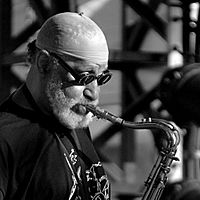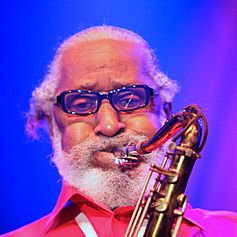Sonny Rollins facts for kids
Quick facts for kids
Sonny Rollins
|
|
|---|---|
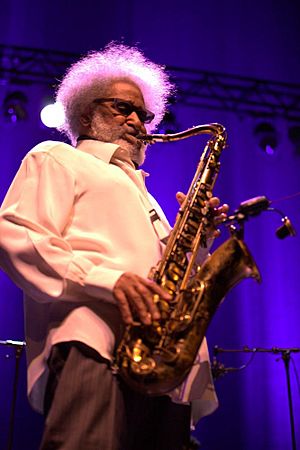
Rollins in 2011
|
|
| Background information | |
| Birth name | Walter Theodore Rollins |
| Born | September 7, 1930 New York City, U.S. |
| Genres |
|
| Occupation(s) |
|
| Instruments | |
| Years active | 1947–2014 |
| Labels |
|
Walter Theodore "Sonny" Rollins (born September 7, 1930) is a retired American jazz tenor saxophonist. Many people consider him one of the most important and influential jazz musicians ever.
Over his long career, which lasted seven decades, Rollins recorded more than 60 albums as a bandleader. He wrote several songs that have become jazz standards, meaning they are played often by other musicians. These include "St. Thomas", "Oleo", and "Doxy". Rollins has been called "the greatest living improviser" for his skill at creating music on the spot. He stopped performing in 2012 due to health issues and officially retired in 2014.
Contents
Early Life and Musical Beginnings
Sonny Rollins was born in New York City. His parents came from the Virgin Islands. He was the youngest of three children and grew up in the Harlem neighborhood. He got his first alto saxophone when he was about seven or eight years old.
Rollins first learned to play the piano. He then switched to the alto saxophone because he was inspired by the musician Louis Jordan. In 1946, he switched again to the tenor saxophone, wanting to be like his hero, Coleman Hawkins. In high school, Rollins was in a band with other students who would also become jazz legends, like Jackie McLean and Kenny Drew.
Career as a Jazz Legend
First Recordings and Rise to Fame
After high school, Rollins started playing music professionally. In 1949, he made his first recordings as a sideman, which means he played in a group led by someone else. He quickly became known for his talent. He recorded with famous musicians like J. J. Johnson, Bud Powell, and Miles Davis.
A big moment for Rollins came in 1954. He recorded his famous songs "Oleo", "Airegin", and "Doxy" with a group led by Miles Davis. These recordings helped establish a style of jazz called hard bop.
In 1955, Rollins joined a popular quintet (a group of five musicians) led by Clifford Brown and Max Roach. After some members of the band died in a car accident in 1956, Rollins continued to play with Roach. He also started to release albums under his own name.
The Saxophone Colossus Album
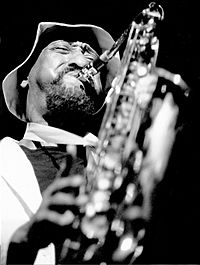
In 1956, Rollins recorded his famous album Saxophone Colossus. It included his best-known song, "St. Thomas". This song was based on a Caribbean calypso tune his mother used to sing to him. The album showed his amazing ability to improvise.
One long solo on the album, called "Blue 7," was so impressive that music experts wrote articles about it. They studied how Rollins used rhythm and repeated patterns to create exciting music. Using calypso rhythms became one of Rollins's signature styles.
New Sounds and a Famous Nickname
In 1957, Rollins started experimenting with a new type of band. He played with only a bass and drums, without a piano. This was unusual at the time and gave his music a very open sound. This style became known as "strolling." Albums like Way Out West and A Night at the Village Vanguard feature this trio format.
Around this time, Rollins got the nickname "Newk" because people thought he looked like the famous baseball pitcher Don Newcombe. In 1958, he was part of a famous photograph called A Great Day in Harlem, which featured dozens of jazz stars. Rollins is the last living musician from that photo.
Taking a Break on the Bridge
By 1959, Rollins felt he needed to improve his playing. He took a break from performing for over two years. To practice without bothering his neighbors, he went to the Williamsburg Bridge in New York City.
Almost every day, for hours at a time, he would stand on the bridge and play his saxophone. This story became a famous example of his dedication to music. When he returned to the jazz world in 1961, he was better than ever. His first album after his break was called The Bridge in honor of his practice spot.
Exploring New Musical Worlds
The 1960s and 70s
Throughout the 1960s, Rollins continued to explore different kinds of music. He recorded albums with Latin rhythms and even worked with free jazz musicians like Don Cherry. In 1966, he recorded the soundtrack for the movie Alfie.
After another short break, Rollins returned in 1971. During the 1970s and 1980s, his music was influenced by R&B, pop, and funk. He started playing in large concert halls and arenas instead of small clubs. In 1981, he played saxophone on three songs for the Rolling Stones' album Tattoo You, including the hit single "Waiting on a Friend".
Later Career and Awards
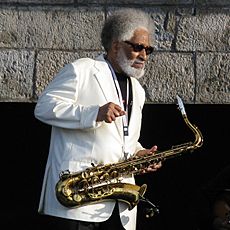
Rollins continued to be a major figure in jazz for decades. In 1995, New York City declared November 13 to be "Sonny Rollins Day."
On September 11, 2001, Rollins was in his apartment near the World Trade Center when the towers collapsed. He had to leave his home with only his saxophone. Just five days later, he performed a concert in Boston. A recording of that show, Without a Song: The 9/11 Concert, won a Grammy Award.
In 2004, Rollins received a Grammy Award for lifetime achievement. In 2010, President Barack Obama awarded him the National Medal of Arts. He celebrated his 80th birthday that year with a special concert at New York's Beacon Theatre.
Rollins gave his last public performance in 2012. He had to retire because of a lung condition called pulmonary fibrosis.
Life After Retirement
Even after retiring, Rollins has remained an important figure. In 2013, he appeared as a guest on the TV show The Simpsons. He also received an honorary doctorate from the famous Juilliard School.
In 2017, he donated his personal collection of notes, recordings, and photos to the Schomburg Center for Research in Black Culture in Harlem. This allows students and researchers to study his life and work. In 2024, a book called The Notebooks of Sonny Rollins was published, sharing his personal writings from 1959 onwards.
Awards and Honors
Sonny Rollins has received many awards for his contributions to music. Some of them include:
- Elected to the Down Beat Jazz Hall of Fame (1973)
- Grammy Award for lifetime achievement (2004)
- Polar Music Prize in Sweden (2007)
- National Medal of Arts (2010)
- Kennedy Center Honors (2011)
- Honorary doctorates from many universities, including Duke, Berklee College of Music, and Juilliard.
See also
 In Spanish: Sonny Rollins para niños
In Spanish: Sonny Rollins para niños


